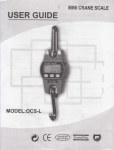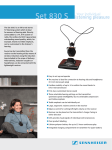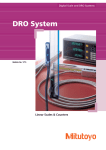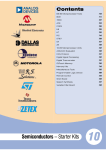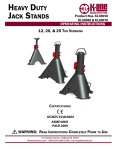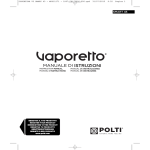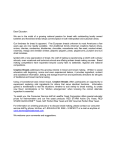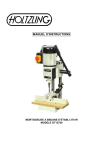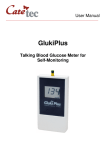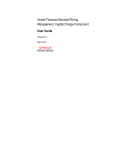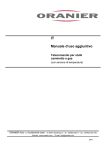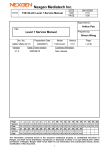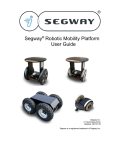Download OPERATING INSTRUCTIONS - K
Transcript
Portable DPF Cleaner Product No. KL22020 OPERATING INSTRUCTIONS A self-contained machine, designed for cleaning Diesel Particulate Filters, that may be transported, set up, and operated in the field. 315 Garden Avenue • Holland, MI 49424 www.klineind.com • 1-800-824-KLINE (5546) • [email protected] Introduction This manual contains information to help you to learn about the safe and proper use of the KL22020 Portable DPF Cleaner. K-Line® Industries, Inc cannot anticipate all conceivable or unique situations. The instructions and warnings included in this manual are not necessarily all-inclusive. You must make sure all conditions and procedures do not jeopardize your personal safety. DISCLAIMER: All information, images, and specifications contained in this manual are based on the latest information available at the time of publication. K-Line® reserves the right to make changes at any time without notifying any person or organization of such revisions or changes. K-Line® is not liable for incidental or consequential damages (including lost profits) in connection with the furnishing, performance, or use of this material. Objective The KL22020 Portable DPF Cleaner is designed to quickly and efficiently remove accumulated ash from diesel particulate filters (DPFs). This is required in one of two situations: (1) Routine service required by your DPF warranty, (2) Indicated by your on-board Emissions Device Monitor (EDM) or other filter service monitor. This user manual provides cleaning instructions for after-treatment diesel particulate filters (DPFs). ÂÂ The after-treatment diesel oxidation catalyst and the after-treatment diesel particulate filter housing must be free of dents. ÂÂ Mounting flanges must be free of dents, cracks, or gouges in order to seal correctly. ÂÂ After-treatment diesel particulate filters should be inspected prior to cleaning using appropriate OE technical procedures. ÂÂ DPF cleaning machines are not designed to clean DPF filters that are plugged as a result of excessive fluids in the exhaust system, such as coolant, fuel, or oil. ÂÂ K-Line is not liable for a pre-existing condition in the DPF that would render the filter unstable, if using the cleaning machine identifies such a condition exists. Particulate filters that do not pass these criteria should be replaced and not cleaned. 2 Table of Contents Safety Precautions . . . . . . . . . . . . . . . . . . . . . . . . . . . . . . 4 Setup . . . . . . . . . . . . . . . . . . . . . . . . . . . . . . . . . . . . . . 5 Install the Neoprene Ring Seal . . . . . . . . . . . . . . . . . . 5 Install the DPF . . . . . . . . . . . . . . . . . . . . . . . . . . . . . 6 Assemble the Fixture . . . . . . . . . . . . . . . . . . . . . . . . . 7 Seat the Nozzle Arm . . . . . . . . . . . . . . . . . . . . . . . . 10 Assemble the Containment Hood . . . . . . . . . . . . . . 11 Air and Electrical Connections . . . . . . . . . . . . . . . . . 12 Control Box . . . . . . . . . . . . . . . . . . . . . . . . . . . . . . . . 13 Cleaning Cycle . . . . . . . . . . . . . . . . . . . . . . . . . . . . . . . 14 Troubleshooting Guide . . . . . . . . . . . . . . . . . . . . . . . . 17 Maintenance . . . . . . . . . . . . . . . . . . . . . . . . . . . . . . . 18 Schedule . . . . . . . . . . . . . . . . . . . . . . . . . . . . . . . . 18 Replace the Ash Bag . . . . . . . . . . . . . . . . . . . . . . . . 18 Replacement Parts . . . . . . . . . . . . . . . . . . . . . . . . . . . . . 20 Case Layout . . . . . . . . . . . . . . . . . . . . . . . . . . . . . . . . 21 Appendix A - Long Reach Nozzle Kit . . . . . . . . . . . . . . . . . 22 Appendix B - Flanged Filter Kit . . . . . . . . . . . . . . . . . . . . 23 Appendix C - Oval DPF Adapter Guide (optional) . . . . . . 24 3 Safety Precautions Before using the KL22020 Portable DPF Cleaner, read, understand, and follow the safety precautions and operating instructions outlined in this manual. This equipment must be operated by qualified personnel. The operator should be familiar with diesel particulate filters. WARNING: Indicates a potentially hazardous situation which, if not avoided, could result in death or serious injury. CAUTION: Indicates a potentially hazardous situation which, if not avoided, may result in minor or moderate injury. CAUTION: Used without the safety alert symbol indicates a potentially hazardous situation which, if not avoided, may result in property damage. Personal Protection/ Important Information Hazard Avoidance WARNING WARNING To avoid personal injury, carefully read and understand all instructions before attempting to operate any equipment or tools. If the operator cannot read these instructions, operating instructions and safety precautions must be read and discussed in the operator’s native language. Inspect both the KL22020 Portable DPF Cleaner and the DPF prior to each use for dents, cracks, gouges or worn parts. If damage is found, discontinue use until inspected and released by an approved inspector. It is important that the DPF is cooled completely prior to cleaning. Never clean a DPF that is too hot to touch. To avoid eye injury, always wear protective glasses or face shield. If there is eye contact with ash, flush eyes with cold water for 30 minutes. Unplug the KL22020 Portable DPF Cleaner prior to any service work. Do not operate on a wet surface. Improper use can result in electrical shock. Use the KL22020 Portable DPF Cleaner in a well ventilated area. Wear a dust mask to avoid breathing the ash. If visible dust escapes the machine during cleaning procedure, immediately stop the process and check all connections. Extension cords may overheat, resulting in a fire. If you must use an extension cord, use shortest possible cord. Personal injury can result from pinch points. Use caution when using the KL22020 Portable DPF Cleaner Wear protective gloves. If there is skin contact with the ash, thoroughly wash the skin with soap and water. Prohibited Action To prevent possible damage to your hearing, always wear ear protection when working around noise generating tools. The noise made during the cleaning cycle is within the acceptable decibel rating for unprotected ears; however, ear protection is recommended. WARNING To avoid damage to the tooling, do not weld on the components. Do not modify the KL22020 Portable DPF Cleaner in any way by welding, heating with a torch, drilling or grinding. 4 Setup Procedure - Install the Neoprene Ring Seal 1. Remove the diesel particulate filter (DPF) from the vehicle according to the appropriate OE technical manual or bulletin regarding DPFs. Remove tie straps, thumb knobs, and lid. 2. Place DPF Cleaner on a sturdy and level surface. 3. Loosen the tie straps and remove the lid from the canister. (Figure 1) Figure 1 Steel Compression Ring 4. Use the tape measure provided in the tool kit to measure the diameter of the DPF at the widest point where it will interface with the neoprene ring seal. 5. Select the proper Neoprene Ring Seal based on the measurement. The KL22020 is shipped with the small neoprene ring seal installed. NOTE: If using the large or medium neoprene ring seal, the steel compression ring under the small seal must be removed. (Figure 2) Figure 2 ÂÂ For DPF’s with a canister diameter of 400 mm – 325 mm use the large ring. ÂÂ For DPF’s with a canister diameter of 325 mm – 235 mm use the medium ring. Ring Seal ÂÂ For DPF’s with a canister diameter of 235 mm – 165 mm use the small ring including the metal supporting ring. Clamping Ring Thumb Knob NOTE: The thumb knobs holding the neoprene ring seal may become loose after time. Periodic tightening may become necessary. 6. Install the ring seal, the clamping ring, and the thumb knobs. Align the tabs in the clamping ring with the straps. Tab 5 Figure 3 Setup Procedure - Install the DPF 1. Carefully place and center the DPF into the stretch Neoprene Ring Seal with the exhaust exit end in the upward position. (Figure 4) Exhaust End of DPF NOTE: Be sure the neoprene ring is sealing against the canister body. Figure 4 2. Select the proper Neoprene Skirt based on the DPF measurement. ÂÂ 400 mm – 285 mm = Beige Velcro ÂÂ 285 mm – 165 mm = White Velcro 3. Place the Neoprene Skirt over DPF with the beige/white Velcro facing up and towards the control box. (Figure 5) Beige / White Velcro Strip Dust Skirt Figure 5 6 Setup Procedure - Assemble the Fixture Leg 1. Assemble the three legs to the fixture as shown in Figure 6. 2. Use the tape measure provided in the tool kit to measure the outer diameter of the DPF at the uppermost edge where the fixture will rest. ÂÂ Note: If the substrate depth is deeper than 87.5 mm (3.444”), use the Long Reach Nozzle Package. See Appendix A ÂÂ If cleaning a Flanged Filter use the Flanged Filter Nozzle Kit. See Appendix B Figure 6 3. Lock the legs into position at the distance measured in Step 2. Legs cannot be smaller than the measured length as the fixture will not fit on the filter. (Figure 7) Leg locked at canister diameter measurement. NOTE: Use this edge to determine the location of the leg based on the measurement taken from the filter. Figure 7 4. Place the Tripod Setting Gage on the top center of the DPF. (Figure 8) Tripod Setting Gauge Figure 8 7 Setup Procedure - Assemble the Fixture contd. 5. Place the fixture on top of the gauge. Slide the feet down onto the lip of the DPF and lock them, centered and evenly, into place. (Figure 9) 6. Remove the fixture and gage from the DPF. Slide feet down to catch the lip of DPF and lock in place. Figure 9 Spring-loaded Ball Snaps into Spindle Detent 7. Select the longest nozzle arm that will clear the legs of the fixture but still reach the outer diameter of the DPF. Connect the nozzle arm to the spindle shaft using an “align, push and twist” movement. The spring-loaded ball should snap into the spindle detent. (Figure 10) NOTE: Make sure the mating parts are free from debris. Figure 10 8. Thread the nozzle onto the arm. A Nozzle Wrench (4422010-6) is supplied to securely fasten it in place. (Figure 11) Nozzle Nozzle Arm Figure 11 8 Setup Procedure - Assemble the Fixture contd. Puck 9. Slide the nozzle puck onto the nozzle. (Figure 12) Drive Disc Foot Figure 12 10.Position the fixture on top of the DPF with connecting receptacles pointing toward the control box. (Figure 13) Figure 13 9 Setup Procedure - Seat the Nozzle Arm 1. Slide the three straps from the DPF Cleaner thru the Neoprene Skirt slots and secure the straps to the fixture. (Figure 14) NOTE: Be sure the straps are applied with equal tension. 2. Rotate the nozzle arm so the drive disc on the end of the arm is off the three cam blocks. Figure 14 3. Manually rotate the drive disc counterclockwise (CCW) until the nozzle and puck are as close to the outer edge of the DPF substrate as possible without touching the canister inner wall, flange wall, or until the puck is fully rested in the filter substrate. (Figure 15) 4. Manually rotate the arm one full revolution clockwise (CW) to verify it is clear of any obstructions. 5. Rotate the nozzle arm by hand until the spring loaded ball snaps into the spindle detent. Figure 15 6. Inspect the puck to ensure there is not a bind and that it is fully rested on the filter substrate. 10 Setup Procedure - Assemble the Containment Hood 1. Attach the 90° elbow to the polycarbonate panel of the Containment Hood. (Figure 16) Figure 16 Vacuum Elbow 2. Place the hood on top of the fixture with flat side toward the control box. 3. Raise the dust skirt and start attaching the Velcro strip to the hood at a point 180° from the flat edge of the hood. (Figure 17) 4. Continue to attach the dust skirt to the hood, working around both sides and ending at the flat edge of the hood. Start Attaching Dust Skirt Here 5. Attach the HEPA vacuum to the 90° elbow. Figure 17 11 Setup Procedure - Air and Electrical Connections 1. Attach the wire lead from the Control Box onto the motor fixture. (Figure 18) Wire Lead 2. Attach the quick connect air line from the valve onto the fixture. NOTE: Carefully check that all wires and hoses are out of the rotation range of the nozzle arm. Air Line 3. Attach a compressed air line into the pneumatic filter/regulator input. Be sure that there is 100 PSI sustained compressor capability. A 3/8 minimum I.D. hose size will be needed and a minimum of 20 CFM compressed air capacity. (Figure 19) Figure 18 Air Input NOTE: The air MUST be clean and free from moisture. 4. Select the preferred input voltage cord and attach it onto the control box and into the power source. Figure 19 This completes the Setup Procedure 12 Control Box 1. Once a DPF has been loaded into the DPF Cleaner according to the instructions in the Setup section of this manual, open the cover of the Control box. (Figure 20) Open Control Box Cover 2. Refer to Figure 21 for explanations of panel button functions. Figure 20 Selector Switch – Sets the speed of the cleaning cycle based on the location of the nozzle. Hour Meter – Shows time elapsed while the cleaning cycle is running. Stop / Start Button – Begins / halts the cleaning cycle O / STOP I / START OFF HOURS 1/10 RESET DISCHARGE Discharge Button – Momentary button used for air blast during teardown procedure. Reset Button – If the nozzle gets stuck during the cleaning cycle, press this button to reset the circuit and continue. Figure 21 13 Cleaning Cycle CAUTION To avoid eye injury, always wear protective glasses or face shield. If there is eye contact with the ash, flush eyes with cold water for 30 minutes. Wear protective gloves. If there is skin contact with the ash, thoroughly was the skin with soap and water. Wear a dust mask to avoid breathing the ash. If visible dust escapes the machine during cleaning procedure, immediately stop the process and check all connections. To prevent possible damage to your hearing, always wear ear protection when working around noise generating tools. 1. There are color ranges on the nozzle arm. (Figure 22) Determine the color range where the nozzle is resting under the nozzle arm. Set the Selector Switch on the Control Panel at the same color. Color Ranges 2. Verify the vacuum hose was attached during the Setup procedure. Start the vacuum. 3. Press and release the Stop/Start Button on the control panel. 4. As the nozzle moves toward the center of the DPF and into a different color on the nozzle arm, change the Selector Switch on the control panel to match the color. Color Ranges NOTE: This speeds up the cleaning cycle. If this is not done, the cycle will still continue at the starting speed but take longer to complete the cycle. Figure 22 5. The nozzle rotates to the center of the DPF and will dwell there until the machine is turned off. NOTE: If there appears to be ash blowing out of the top of the DPF during the cleaning process, it could mean the DPF is cracked. NOTE: If the nozzle sticks in one spot during the cleaning cycle, it may trip the reset button. Tech Tip 1. Move the selector switch back to the OFF position to free the nozzle. The DPF Cleaner can help protect the DPF from the elements. Engage the pin on the underside of the lid into the pin hole located on top of the motor enclosure. This helps protect the DPF from moisture. 2. Press the Reset Button. 3. Change the location of the Selector Switch, if needed. 4. Press and release the Stop / Start Button. 14 Cleaning Cycle 1. Detach the air line and wire lead from the fixture base. (Figure 23) Wire Lead 2. Remove the hood, dust skirt, and fixture base from the DPF. Air Line Figure 23 Air Line to Air Blast Port 3. Attach the air line that was removed from the fixture to the air blast port on the intermediate base. (Figure 24) Figure 24 15 Cleaning Cycle 4. Use the compressed air nozzle to lightly blow through the top of the DPF, covering the entire area of the substrate face. (Figure 25) This exercise helps to dislodge the ash that clings to the underside of the DPF. 5. Apply five (5) quick blasts of air by pressing the discharge button on the control panel five (5) times. Use a quick (one second) press and release motion. Figure 25 CAUTION To prevent personal injury, use five quick (one second each) blasts of air. If the blasts of air are too long, or if too many are applied, it may pressurize the canister, forcing ash to escape from the sealing areas. Wear an N95-rated dust mask to avoid breathing the ash. Insert Vacuum Hose 6. Remove the rubber plug from the intermediate base and insert the hose from the vacuum. (Figure 26) 7. Turn on the vacuum and slowly lift the DPF from the machine. 8. Once the DPF has been removed, turn off the vacuum and replace the rubber plug. 9. Install the lid on the DPF Cleaner and fasten the straps to keep ash from escaping. 10.Disconnect the DPF Cleaner from the power supply. Figure 26 This completes the Cleaning Cycle 16 Troubleshooting Guide SYMPTOM SOLUTION Ash is observed leaking from the DPF Cleaner. 1. Stop the cleaning cycle. Look for damage on DPF sealing surface and cracks in the DPF. 2. Stop the cleaning cycle. Verify all ports on DPF have been plugged. 3. Stop the cleaning cycle. Check all connections. 4. Thumb knobs will loosen over time. Check and tighten all thumb knobs. Ash is observed leaking from the DPF. 1. Stop the cleaning cycle. Remove the DPF from the machine and inspect for cracks. Ash is observed leaking from the vacuum cleaner. 1. Verify the ash collection cover is securely closed and latched. 2. Look for damage in the cover seal. DPF is not clean after performing a cleaning cycle. 1. Check the orientation of DPF to verify the exhaust end of the DPF is positioned correctly. Refer to the section of this user manual named Setup Procedure - Install the DPF. 2. Look for other DPF conditions that may prevent successful cleaning. Nozzle sticks in one spot. If the nozzle sticks in one spot during the cleaning cycle, it will trip the reset button. Follow these steps to continue the cleaning cycle : 1. Move the selector switch back to the OFF position to free the nozzle. 2. Press the reset button. 3. Change the location of the selector switch, if needed. 4. Press and release the stop / start button. Puck is suspended above the DPF substrate. 1. Refer to the Setup Procedure - Assemble the Fixture section of this user manual and seat the puck back onto the DPF surface. 17 Maintenance - Schedule COMPONENT SCHEDULE Air Filter / Regulator Inspect before each use of the DPF Cleaner. Clean as needed if water or dirt are found. Air Hoses Inspect for cracks and other damage after every 50 hours of operation. Replace as needed. Ash Bag Replace after every 10 hours of operation. Electrical Cords Inspect for cracks and other damage after every 50 hours of operation. Replace as needed. Neoprene Ring Seals Inspect for rips and other damage after every 10 hours of operation. Replace as needed. Tie Straps Inspect for rips and other damage after every 50 hours of operation. Replace as needed. Maintenance - Replace the Ash Bag CAUTION To avoid eye injury, always wear protective glasses or face shield. If there is eye contact with the ash, flush eyes with cold water for 30 minutes. the ash. Perform this procedure in an enclosed area free of air movement. Wear a dust mask (rated N95) to avoid breathing in Never operate the DPF Cleaner without an ash bag installed in the canister. Wear protective gloves. If there is skin contact with the ash, thoroughly was the skin with soap and water. This procedure is written for using Ash Bag Replacement Kit No. KL22056. Removal Clamp 1. Disconnect the DPF Cleaner from the power source. 2. Unclamp and remove the intermediate ring from the canister. (Figure 27) Intermediate Ring Figure 27 18 Maintenance - Replace the Ash Bag contd. 3. Remove the backing from the sealing membrane and adhere the membrane to the top of the ash bag. (Figure 28) 4. Lift the ash bag from the canister. Figure 28 5. Slowly and gently press the air out of the ash bag. (Figure 29) Gently press air out of ash bag. 6. Insert and seal the ash bag into the recloseable bag provided in the replacement kit. Figure 29 Installation 1. Install the new ash bag into the canister, folding the bag evenly around the outside edge. 2. Reinstall the intermediate ring and clamp it to the canister, ensuring a tight seal to the ash bag. (Figure 30) 3. Vacuum clean the DPF Cleaner and the surrounding area as needed. Clamp 4. Dispose of the used ash bag according to federal, state, and local regulations regarding hazardous waste. Figure 30 19 Replacement Parts KIT # DESCRIPTION KL22050A Small Neoprene Skirt KL22050B Large Neoprene Skirt KL22051 Wet / Dry Hang Up HEPA Vacuum KL22052 Small Seal and O-Ring Kit (165 mm - 235 mm) •Sm. Neoprene Sealing Disc •Puck O-Ring •Nozzle O-Ring •Roller Body O-Ring KL22053 Med. Seal and O-Ring Kit (235 mm - 325 mm) •Med. Neoprene Sealing Disc •Puck O-Ring •Nozzle O-Ring •Roller Body O-Ring KL22054 Large Seal and O-Ring Kit (325 mm - 400 mm) •Lg. Neoprene Sealing Disc •Puck O-Ring •Nozzle O-Ring •Roller Body O-Ring KL22056 Ash Disposal Kit •Filter Disc (5 Ea) •Trash Bag (5 Ea) •24” X 24” Zip Lock Bag (5 Ea) •Disposal Flat Fold Respirator (5 Ea) KL22057 Replacement HEPA Filter for KL22051 KL22058 Long Knife Kit KL22059 Short Knife Kit KL22060 Strap Assembly Kit KL22061 Hardware Kit •Leg Thumb Screw •Adjustment Leg Screw Assembly •Intermediate Base Thumb Screw (4 Ea) •Elbow Attachment •Conduit Fitting Locknut (2 Ea) •M6x1x25 Mm Shoulder Screw KL22062 KIT # Hose/Plug Assembly Kit •Hose Clamp (2 Ea) •24 Volt Dc Power Cord •AC Power Cord (110) •Blow Gun Hose •Quick Connect Hose 20 DESCRIPTION KL22063 Fixture Leg Assembly Kit •Filter Guide Standoff (3 Ea) KL22064 Short Nozzle Kit •Nozzle Cap Assembly •Short Inner Nozzle Holder Assembly •Nozzle Wrench KL22065 Long Nozzle Kit •Nozzle Cap Assembly •Long Inner Nozzle Holder Assembly •Nozzle Wrench KL22066 Flange Filter Nozzle Kit •Flange Filter Nozzle Assembly •Mounting Bolt •1/8 Hex L-Key KL22067 Adjustment Foot Kit •Adjustment Foot (3 Ea) KL22068 Flange Filter Adjustment Foot Kit •Long Adjustment Foot (3 Ea) KL22069 Wheel Kit •Wheel (2 Ea) •Shaft Collar (2 Ea) KL22070 Pull Action Clamp Kit •Pull Action Clamp (2 Ea) KL22071 Cover Assembly Kit KL22072 Filter Ring Kit •Small Compression Ring W/ Edge Protector •Top Compression Ring KL22073 Intermediate Base Kit KL22074 Rubber Stop Assembly Kit KL22075 Dust Cover Assembly Kit KL22076 Valve Package/Filter Regulator Kit •3/8 Npt Long Nipple •Filter Regulator •3/8 Breather Vent •Valve Package Assembly KL22077 Electrical Box Kit KL22078 Rotating Base Kit KL22080 Gage Assembly Case Layout 4 3 1 5 6 7 2 9 10 11 13 14 15 12 16 17 ITEM IN KIT # DESCRIPTION 1 KL22078 DPF Rotating Base 2 KL22068 Adjustment Foot - Long 3 KL22080 Gage Assembly 4 KL22063 Filter Guide Standoff Assembly 5 KL22066 Flange Filter Nozzle Assembly 6 KL22066 Mounting Bolt 7 KL22066 1/8” Hex Key 8 KL22058 Long DPF Knife 9 KL22059 Short DPF Knife 10 KL22061 Modified Elbow 11 KL22061 Conduit Lock Nut 12 4422012 Tape Measure 13 KL22065 Nozzle Wrench 14 KL22064 Short Inner Nozzle Holder Assembly 15 KL22064/5 16 KL22061 Shoulder Screw 17 KL22065 Long Inner Nozzle Holder Assembly Nozzle Cap Assembly 21 8 Appendix A - Long Reach Nozzle Kit The following instructions are for use on filters having a substrate depth GREATER than 87.5 mm (3.444”). NOTE: DO NOT use on filters having substrate depths of 87.5 mm and less. 1. Prior to setting the tripod setting gauge on filter, install three (3) shoulder screw extensions (provided). (Figure 1A) Shoulder Screw Extension 2. Continue with Steps 5 - 7 in the Setup Procedure - Assemble the Fixture. Figure 1A 102 mm Long Reach Nozzle 3. Thread the Long Reach Nozzle onto the arm and use the wrench provided to fasten it in place. (Figure 2A) 4. Continue with the Setup Procedure. Nozzle Arm Figure 2A 22 Appendix B - Flanged Filter Nozzle Kit 1. Install three (3) shoulder screw extensions (provided) on the tripod setting gauge. (Figure 1B) Place the gauge on top of and centered on the DPF. Shoulder Screw Extension 2. Replace the feet on the fixture with the longer feet provided in the kit. (Figure 2B) 3. Place the fixture on top of the gauge with the legs locked at the flange canister measurement. NOTE: When measuring the outer diameter of the flange add 50 mm to the measurement. Figure 1B 4. Slide the feet down to catch the lip of the DPF, and lock them evenly in place. 5. Remove the fixture and gauge from the DPF. 6. Select the longest nozzle arm that will clear the legs of the fixture but still reach the outer diameter of the DPF. Connect the nozzle arm to the spindle shaft using an “align, push, and twist” movement. The spring-loaded ball should snap into the spindle detent. (Figure 3B) Figure 2B Spring-loaded Ball Snaps into Spindle Detent. 7. Install the flange nozzle onto the nozzle arm using the supplied mounting nut. Install with the bent part of the nozzle parallel to the nozzle arm and pointing toward the center of the unit. Tighten the nut with the supplied hex key wrench. (Figure 4B) 8. Continue with the Setup Procedure. Figure 3B Nozzle Arm Nozzle Arm Flange Nozzle Disc Drive Complete Assembly Figure 4B 23 Appendix C - Oval DPF Adapter Guide (optional) NOTE: This Appendix is to describe the proper use of the KL22079 Oval DPF Adapter which is needed to clean Kubota Engine style Diesel Particulate Filters. 1. Place the DPF Oval Adapter Base into the Neoprene sleeve on the KL22020 DPF Cleaner. Check the seal around the edge to ensure a snug fit. Image 1: Step 1 2. Insert the DPF into the Oval Adapter (Gas Flow Arrow Up) by lining up the pegs with the mounting bolt holes. Press down firmly to ensure preper contact with the seal at the bottom of the adapter. Image 2: Step 2 3. Place the sliding Adapter Top onto the DPF by aligning the pegs to the mounting holes. Image 3: Step 3 4. Assemble the DPF Cleaning Spider Fixture (KL22078) with the legs set at 330mm. Image 4: Step 4 24 Appendix C - Oval DPF Adapter Guide (optional) 5. Place the Spider Fixture onto the top plate and ensure the nozzle puck is floating on the filter surface. Slide the Adapter Top all the way to the left. 6. Adjust the nozzle on the knife arm so that the nozzle is just barely clearing the DPF wall. Begin the cleaning procedure on the control board. When the nozzle centers out, turn off the DPF Cleaner. Image 5: Step 5 7. Slide the Top Adapter all the way to the right and reset the Nozzle so that it barely clears the DPF wall. Repeat the cleaning procedure. 8. Center the Adapter Top and reset the nozzle so that it barely clears the DPF wall. Repeat the cleaning procedure. Image 6: Step 7 25 NOTES 26 NOTES 27 For product information or to purchase replacement parts CONTACT K-LINE CUSTOMER SERVICE AT 1-800-824-KLINE (5546) Local: (616) 396-3564 Fax: 1-800-528-9138 or (616) 396-8974 [email protected] www.klineind.com Copyright 2012 K-Line® Industries, Inc. 4422020-200 Rev B 8/12




























